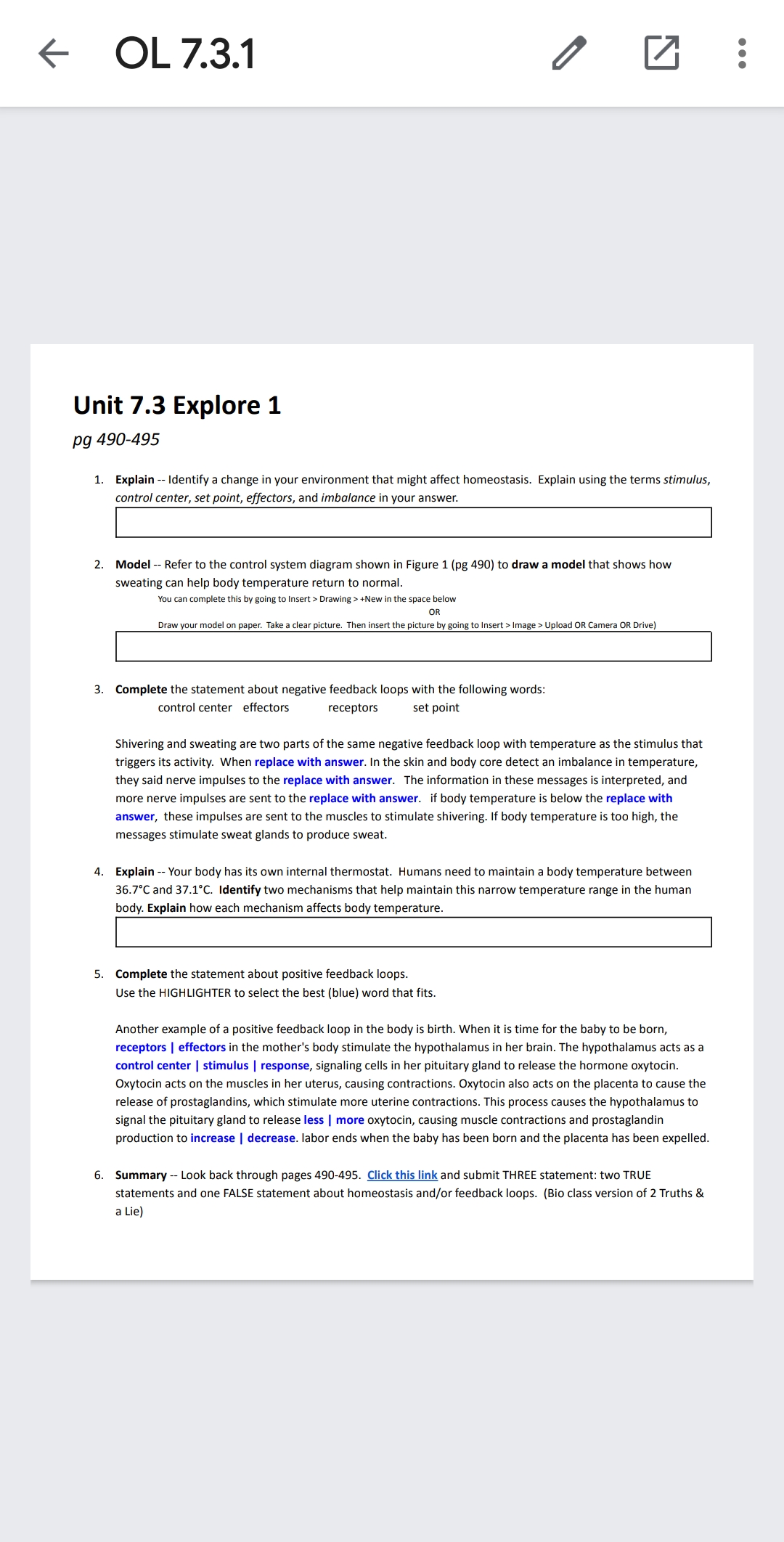Ünit 7.3 Explore 1 pg 490-495 1. Explain -- Identify a change in your environment that might affect homeostasis. Explain using the terms stimulus, control center, set point, effectors, and imbalance in your answer.
Ünit 7.3 Explore 1 pg 490-495 1. Explain -- Identify a change in your environment that might affect homeostasis. Explain using the terms stimulus, control center, set point, effectors, and imbalance in your answer.
Biochemistry
6th Edition
ISBN:9781305577206
Author:Reginald H. Garrett, Charles M. Grisham
Publisher:Reginald H. Garrett, Charles M. Grisham
Chapter27: Metabolic Integration And Organ Specialization
Section: Chapter Questions
Problem 14P
Related questions
Question

Transcribed Image Text:E OL 7.3.1
Unit 7.3 Explore 1
pg 490-495
1. Explain -- Identify a change in your environment that might affect homeostasis. Explain using the terms stimulus,
control center, set point, effectors, and imbalance in your answer.
2. Model -- Refer to the control system diagram shown in Figure 1 (pg 490) to draw a model that shows how
sweating can help body temperature return to normal.
You can complete this by going to Insert > Drawing > +New in the space below
OR
Draw your model on paper. Take a clear picture. Then insert the picture by going to Insert > Image > Upload OR Camera OR Drive)
3. Complete the statement about negative feedback loops with the following words:
control center effectors
receptors
set point
Shivering and sweating are two parts of the same negative feedback loop with temperature as the stimulus that
triggers its activity. When replace with answer. In the skin and body core detect an imbalance in temperature,
they said nerve impulses to the replace with answer. The information in these messages is interpreted, and
more nerve impulses are sent to the replace with answer. if body temperature is below the replace with
answer, these impulses are sent to the muscles to stimulate shivering. If body temperature is too high, the
messages stimulate sweat glands to produce sweat.
4. Explain - Your body has its own internal thermostat. Humans need to maintain a body temperature between
36.7°C and 37.1°C. Identify two mechanisms that help maintain this narrow temperature range in the human
body. Explain how each mechanism affects body temperature.
5. Complete the statement about positive feedback loops.
Use the HIGHLIGHTER to select the best (blue) word that fits.
Another example of a positive feedback loop in the body is birth. When it is time for the baby to be born,
receptors | effectors in the mother's body stimulate the hypothalamus in her brain. The hypothalamus acts as a
control center | stimulus | response, signaling cells in her pituitary gland to release the hormone oxytocin.
Oxytocin acts on the muscles in her uterus, causing contractions. Oxytocin also acts on the placenta to cause the
release of prostaglandins, which stimulate more uterine contractions. This process causes the hypothalamus to
signal the pituitary gland to release less | more oxytocin, causing muscle contractions and prostaglandin
production to increase | decrease. labor ends when the baby has been born and the placenta has been expelled.
6. Summary -- Look back through pages 490-495. Click this link and submit THREE statement: two TRUE
statements and one FALSE statement about homeostasis and/or feedback loops. (Bio class version of 2 Truths &
a Lie)
0..
Expert Solution
This question has been solved!
Explore an expertly crafted, step-by-step solution for a thorough understanding of key concepts.
This is a popular solution!
Trending now
This is a popular solution!
Step by step
Solved in 2 steps

Knowledge Booster
Learn more about
Need a deep-dive on the concept behind this application? Look no further. Learn more about this topic, biology and related others by exploring similar questions and additional content below.Recommended textbooks for you

Biochemistry
Biochemistry
ISBN:
9781305577206
Author:
Reginald H. Garrett, Charles M. Grisham
Publisher:
Cengage Learning

Anatomy & Physiology
Biology
ISBN:
9781938168130
Author:
Kelly A. Young, James A. Wise, Peter DeSaix, Dean H. Kruse, Brandon Poe, Eddie Johnson, Jody E. Johnson, Oksana Korol, J. Gordon Betts, Mark Womble
Publisher:
OpenStax College


Biochemistry
Biochemistry
ISBN:
9781305577206
Author:
Reginald H. Garrett, Charles M. Grisham
Publisher:
Cengage Learning

Anatomy & Physiology
Biology
ISBN:
9781938168130
Author:
Kelly A. Young, James A. Wise, Peter DeSaix, Dean H. Kruse, Brandon Poe, Eddie Johnson, Jody E. Johnson, Oksana Korol, J. Gordon Betts, Mark Womble
Publisher:
OpenStax College


Biology 2e
Biology
ISBN:
9781947172517
Author:
Matthew Douglas, Jung Choi, Mary Ann Clark
Publisher:
OpenStax

Human Physiology: From Cells to Systems (MindTap …
Biology
ISBN:
9781285866932
Author:
Lauralee Sherwood
Publisher:
Cengage Learning

Biology (MindTap Course List)
Biology
ISBN:
9781337392938
Author:
Eldra Solomon, Charles Martin, Diana W. Martin, Linda R. Berg
Publisher:
Cengage Learning